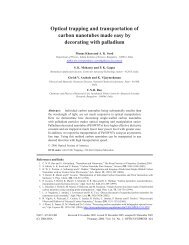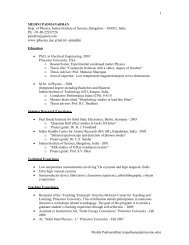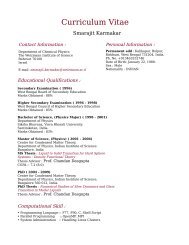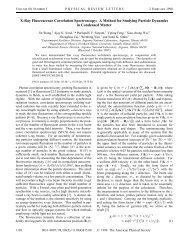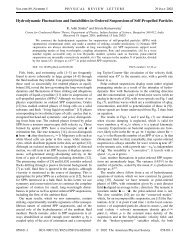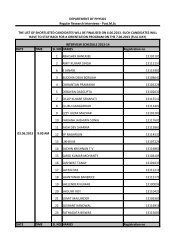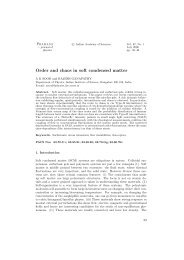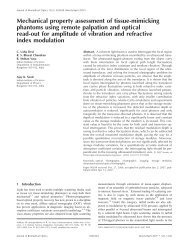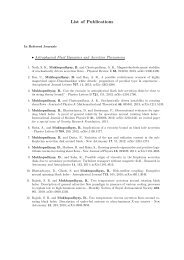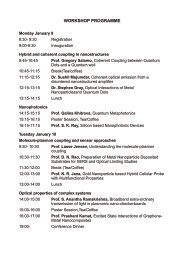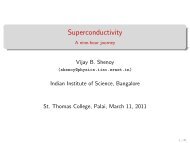Thermoelectric Properties of Fe0.2Co3.8Sb12-xTex ... - Physics
Thermoelectric Properties of Fe0.2Co3.8Sb12-xTex ... - Physics
Thermoelectric Properties of Fe0.2Co3.8Sb12-xTex ... - Physics
You also want an ePaper? Increase the reach of your titles
YUMPU automatically turns print PDFs into web optimized ePapers that Google loves.
Universal Conductance Fluctuations as a direct probe to valley coherence and<br />
universality class <strong>of</strong> disordered graphene<br />
Vidya Kochat, Atindra Nath Pal and Arindam Ghosh<br />
Department <strong>of</strong> <strong>Physics</strong>, Indian Institute <strong>of</strong> Science, Bangalore – 560012.<br />
Quantum interference <strong>of</strong> carriers produces reproducible fluctuations <strong>of</strong> the order <strong>of</strong> e 2 /h in the<br />
electrical conductance <strong>of</strong> mesoscopic semiconductors and metal films as the Fermi energy, magnetic field or<br />
disorder configuration is varied. Both universal conductance fluctuations (UCF) and weak localization (WL)<br />
effects are inevitable components <strong>of</strong> quantum transport in disordered metals at low temperatures as they<br />
encode crucial information on phase coherence, nature <strong>of</strong> scattering and symmetry properties <strong>of</strong> the<br />
Hamiltonian that govern the level statistics <strong>of</strong> the underlying disordered system. Unlike in conventional metal<br />
films and doped semiconductors where UCF and WL are mainly due to inelastic scattering mechanisms, the<br />
scenario in graphene is more complex due to the existence <strong>of</strong> two degenerate valleys (K and K’) in its<br />
hexagonal Brillouin zone. The quantum correction to conductivity in graphene is determined by the elastic<br />
scattering mechanisms involving the valleys, namely the inter-valley and intra-valley scattering, in addition to<br />
the phase breaking inelastic scattering events and these competing mechanisms are reflected in the WL and<br />
weak anti-localization <strong>of</strong> carriers.<br />
Here we present the first unambiguous observation <strong>of</strong> the effect <strong>of</strong> valley symmetry on UCF in<br />
monolayer disordered graphene. The UCF magnitude within a single phase coherent box in graphene is<br />
suppressed by an exact factor <strong>of</strong> four as the carrier density is increased from close to the Dirac point, where<br />
long range Coulomb potential fluctuations dominate, to the high electron or hole density regime, where<br />
potential fluctuations are primarily short range in nature. This also implies a density dependent crossover <strong>of</strong><br />
the universality class <strong>of</strong> graphene from symplectic near the Dirac point to orthogonal at high densities. We also<br />
find that in the presence <strong>of</strong> a magnetic field, the UCF magnitude decreases by an exact factor <strong>of</strong> two and this<br />
corresponds to a transition from the symplectic / orthogonal ensemble to the unitary ensemble characterized<br />
by the absence <strong>of</strong> time reversal symmetry. This work also examines the robustness <strong>of</strong> time reversal symmetry<br />
in mesoscopic graphene which has been controversial owing to pseudo-magnetic fields arising from ripples,<br />
local moments at edges etc.<br />
The valleys which resemble a spin-like entity can be exploited to form the platform for a new<br />
emerging field termed as valleytronics, having applications ranging from valley-based quantum computation,<br />
to valley filters or polarizers. Our experiments underline a new method using UCF that can probe the valley<br />
coherent states in graphene at low temperatures.<br />
Reference:<br />
Atindra Nath Pal, Vidya Kochat and Arindam Ghosh, Phys. Rev. Lett. 109, 196601 (2012).



